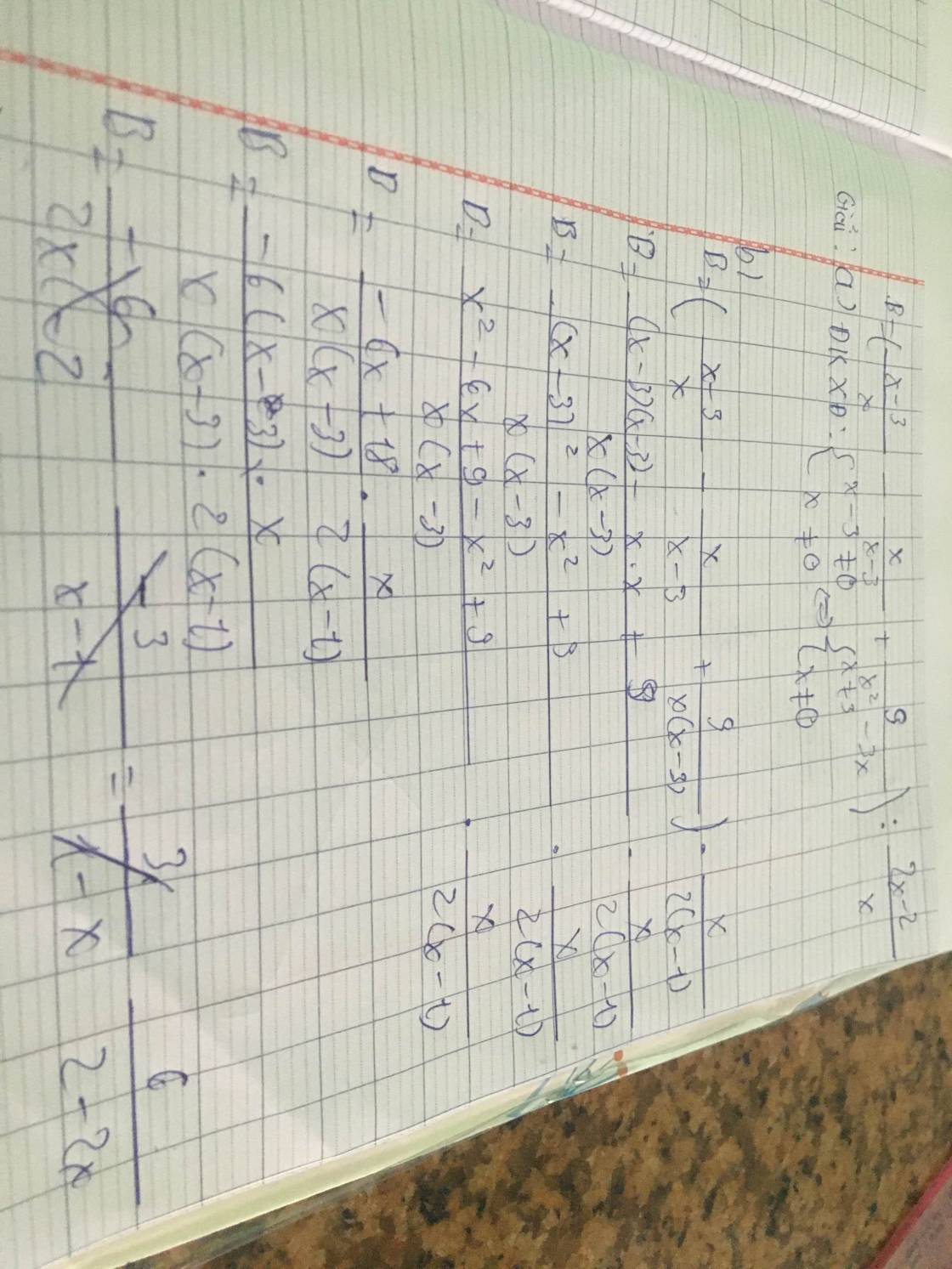P=(1/√x-2+1/√x+2):2x/x-4 (x>0, x≠4)
a,rút gọn P
b,tìm giá trị của x để P<1
Cho biểu thức:
P=( 3+x/3-x - 3-x/3+x + 4x²/x²-9 ) : ( 2x+1/x+3 - 1 )
a) Rút gọn P
b) Tìm giá trị của P biết: 2x²-5x+2=0
c) Tìm các giá trị nguyên của x để P có giá trị nguyên dương.
a: \(P=\left(\dfrac{-\left(x+3\right)}{x-3}+\dfrac{x-3}{x+3}+\dfrac{4x^2}{x^2-9}\right):\dfrac{2x+1-x-3}{x+3}\)
\(=\dfrac{-x^2-6x-9+x^2-6x+9+4x^2}{\left(x-3\right)\left(x+3\right)}\cdot\dfrac{x+3}{x-2}\)
\(=\dfrac{4x^2-12x}{x-3}\cdot\dfrac{1}{x-2}=\dfrac{4x}{x-2}\)
b: \(2x^2-5x+2=0\)
=>(x-2)(2x-1)=0
=>x=1/2
Thay x=1/2 vào P, ta được:
\(P=\left(4\cdot\dfrac{1}{2}\right):\left(\dfrac{1}{2}-2\right)=2:\dfrac{-3}{2}=\dfrac{-4}{3}\)
Cho P=\(\left(\dfrac{2+x}{2-x}+\dfrac{4x^2}{x^2-4}-\dfrac{2-x}{2+x}\right):\dfrac{x^2-3x}{2x^2-x^3}\)
a,Tìm điều kiện của x để giá trị của P xác định
b,Rút gọn P
c,Tính giá trị của P với |x-5|=2
Cho P=\(\left(\dfrac{2+x}{2-x}+\dfrac{4x^2}{x^2-4}-\dfrac{2-x}{2+x}\right):\dfrac{x^2-3x}{2x^2-x^3}\)
a,Tìm điều kiện của x để giá trị của P xác định
b,Rút gọn P
c,Tính giá trị của P với |x-5|=2
a)Đk:\(\left\{{}\begin{matrix}x^2-4\ne0\\2x^2-x^3\ne0\\x^2-3x\ne0\end{matrix}\right.\)\(\Leftrightarrow\left\{{}\begin{matrix}\left(x-2\right)\left(x+2\right)\ne0\\x^2\left(2-x\right)\ne0\\x\left(x-3\right)\ne0\end{matrix}\right.\)\(\Leftrightarrow x\ne\left\{2;-2;0;3\right\}\)
b)\(P=\left[\dfrac{\left(2+x\right)^2}{\left(2+x\right)\left(2-x\right)}+\dfrac{4x^2}{\left(x-2\right)\left(x+2\right)}-\dfrac{\left(2-x\right)^2}{\left(2+x\right)\left(2-x\right)}\right]:\dfrac{x\left(x-3\right)}{x^2\left(2-x\right)}\)
\(=\dfrac{\left(2+x\right)^2-4x^2-\left(2-x\right)^2}{\left(2+x\right)\left(2-x\right)}.\dfrac{x^2\left(2-x\right)}{x\left(x-3\right)}\)
\(=\dfrac{4+4x+x^2-4x^2-4+4x-x^2}{\left(2+x\right)\left(2-x\right)}.\dfrac{x\left(2-x\right)}{x-3}\)
\(=\dfrac{x\left(8x-4x^2\right)}{\left(2+x\right)\left(x-3\right)}\) (sai đề chỗ nào ko em)
c)\(\left|x-5\right|=2\Leftrightarrow\left[{}\begin{matrix}x-5=2\\x-5=-2\end{matrix}\right.\)\(\Leftrightarrow\left[{}\begin{matrix}x=7\left(tm\right)\\x=3\left(ktm\right)\end{matrix}\right.\)
Thay x=7 vào bt P ta được: \(P=\dfrac{7\left(8.7-4.7^2\right)}{\left(2+7\right)\left(7-3\right)}=-\dfrac{245}{9}\)
cho phân thức: \(\dfrac{x^2-4x+4}{x^2-4}\)
a, Với giá trị nào của x thì giá trị của phân thức xác định
b, Hãy rút gọn phân thức
c, Tính giá trị của phân thức tại |x|=3
d, Tìm giá trị của x để giá trị của phân thức bằng 2
a, ĐKXĐ: x2-4≠0 ⇔ x≠±2
b, \(\dfrac{x^2-4x+4}{x^2-4}\)=\(\dfrac{\left(x-2\right)^2}{\left(x-2\right)\left(x+2\right)}\)=\(\dfrac{x-2}{x+2}\)
c, |x|=3
TH1: x≥0 thì x=3 (TMĐK)
TH1: x<0 thì x=-3 (TMĐK)
Thay x=3 và biểu thức ta có:
\(\dfrac{3-2}{3+2}\)=\(\dfrac{1}{5}\)
Thay x=-3 và biểu thức ta có:
\(\dfrac{-3-2}{-3+2}\)=5
cho phân thức: \(\dfrac{x^2-4x+4}{x^2-4}\)
a, Với giá trị nào của x thì giá trị của phân thức xác định
b, Hãy rút gọn phân thức
c, Tính giá trị của phân thức tại |x|=3
d, Tìm giá trị của x để giá trị của phân thức bằng 2
`a)ĐK:x^2-4 ne 0<=>x^2 ne 4`
`<=>x ne 2,x ne -2`
`b)A=(x^2-4x+4)/(x^2-4)`
`=(x-2)^2/((x-2)(x+2))`
`=(x-2)/(x+2)`
`c)|x|=3`
`<=>` \(\left[ \begin{array}{l}x=3\\x=-3\end{array} \right.\)
`<=>` \(\left[ \begin{array}{l}A=\dfrac{3-2}{3+2}=\dfrac15\\x=\dfrac{-3-2}{-3+2}=5\end{array} \right.\)
`d)A=2`
`=>x-2=2(x+2)`
`<=>x-2=2x+4`
`<=>x=-6`
a, ĐKXĐ: \(x^2-4\ne0\Leftrightarrow x\ne\pm2\)
b, Ta có: \(\dfrac{x^2-4x+4}{x^2-4}=\dfrac{\left(x-2\right)^2}{\left(x-2\right)\left(x+2\right)}=\dfrac{x-2}{x+2}\) (*)
c, \(\left|x\right|=3\Rightarrow x=\pm3\)
_ Thay x = 3 vào (*), ta được: \(\dfrac{3-2}{3+2}=\dfrac{1}{5}\)
_ Thay x = -3 vào (*), ta được: \(\dfrac{-3-2}{-3+2}=5\)
d, Có: \(\dfrac{x-2}{x+2}=2\)
\(\Leftrightarrow x-2=2\left(x+2\right)\)
\(\Leftrightarrow x-2=2x+4\)
\(\Leftrightarrow x=-6\left(tm\right)\)
Vậy...
Cho biểu thức B=( x-3/ x - x / x-3 + 9/x^2-3x) :2x-2/x a, Tìm ĐKXĐ và rút gọn biểu thức B b, Tìm giá trị của x để B=2 c, Tìm giá trị nguyên của x để B nhận giá trị nguyên
Mình cần gấp ạ nhanh giúp tui :)) Cảm ơn
 c/
c/
Ta có : B=2=>6/2-2x
<=>6=4-4x
<=>6-4=-4x
<=>-4x=2
<=>x=2/-4=-1/2
d/ĐKXĐ:2-2x≠0
<=>2(1-x)≠0<=>-2(x-1)≠0
<=>x≠1
Để giá trị của biểu thức B nguyên thì 2-2x là Ư(6)
=>2-2x ∈ Ư(6)={±1;±2;±3;±6) Nếu 2-2x=1=> -2x=-1=>x=1/2( thoả mãng)
Rồi còn nhiêu bạn tự xét trường hợp y trang cách làm ở trênn nnhan :;)).À sẽ có mấy cái trường hợp nó giống ĐKXĐ thì bạn ghi trong ngoặc ko thoã mãn nhan.
Cho biểu thức: A=\(\left(\dfrac{x}{x^2-4}+\dfrac{2}{2-x}+\dfrac{1}{x+2}\right):\left(x-2+\dfrac{10-x^2}{x+2}\right)\)
a, Rút gọn biểu thức A
b, Tính giá trị biểu thức A tại x, biết |x|=\(\dfrac{1}{2}\)
c, Tìm giá trị của x để A<0
Cho biểu thức: A=\(\left(\dfrac{x}{x^2-4}+\dfrac{2}{2-x}+\dfrac{1}{x+2}\right)\left(x-2+\dfrac{10-x^2}{x+2}\right)\)
a, Rút gọn biểu thức A
b, Tính giá trị biểu thức A tại x, biết |x|=\(\dfrac{1}{2}\)
c, Tìm giá trị của x để A<0
a, ĐKXĐ: x≠±2
A=\(\left(\dfrac{x}{x^2-4}+\dfrac{2}{2-x}+\dfrac{1}{x+2}\right)\left(x-2+\dfrac{10-x^2}{x+2}\right)\)
A=\(\left(\dfrac{x}{x^2-4}-\dfrac{2x+4}{x^2-4}+\dfrac{x-2}{x^2-4}\right)\left(\dfrac{x^2+2x}{x+2}-\dfrac{2x+4}{x+2}+\dfrac{10-x^2}{x+2}\right)\)
A=\(\left(\dfrac{-6}{x^2-4}\right)\left(\dfrac{6}{x+2}\right)\)
A=\(\dfrac{-36}{\left(x-2\right)\left(x+2\right)^2}\)
b, |x|=\(\dfrac{1}{2}\)
TH1z: x≥0 ⇔ x=\(\dfrac{1}{2}\) (TMĐKXĐ)
TH2: x<0 ⇔ x=\(\dfrac{-1}{2}\) (TMĐXĐ)
Thay \(\dfrac{1}{2}\), \(\dfrac{-1}{2}\) vào A ta có:
\(\dfrac{-36}{\left(\dfrac{1}{2}-2\right)\left(\dfrac{1}{2}+2\right)^2}\)=\(\dfrac{96}{25}\)
\(\dfrac{-36}{\left(\dfrac{-1}{2}-2\right)\left(\dfrac{-1}{2}+2\right)^2}\)=\(\dfrac{32}{5}\)
c, A<0 ⇔ \(\dfrac{-36}{\left(x-2\right)\left(x+2\right)^2}\) ⇔ (x-2)(x+2)2 < 0
⇔ {x-2>0 ⇔ {x>2
[ [
{x+2<0 {x<2
⇔ {x-2<0 ⇔ {x<2
[ [
{x+2>0 {x>2
⇔ x<2
Vậy x<2 (trừ -2)
Cho biểu thức: A=\(\left(\dfrac{x}{x^2-4}+\dfrac{2}{2-x}+\dfrac{1}{x+2}\right):\left(x-2+\dfrac{10-x^2}{x+2}\right)\)
a, Rút gọn biểu thức A
b, Tính giá trị biểu thức A tại x, biết |x|=\(\dfrac{1}{2}\)
c, Tìm giá trị của x để A<0